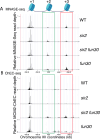Sir2 and Fun30 regulate ribosomal DNA replication timing via MCM helicase positioning and nucleosome occupancy
- PMID: 39831552
- PMCID: PMC11745493
- DOI: 10.7554/eLife.97438
Sir2 and Fun30 regulate ribosomal DNA replication timing via MCM helicase positioning and nucleosome occupancy
Abstract
The association between late replication timing and low transcription rates in eukaryotic heterochromatin is well known, yet the specific mechanisms underlying this link remain uncertain. In Saccharomyces cerevisiae, the histone deacetylase Sir2 is required for both transcriptional silencing and late replication at the repetitive ribosomal DNA (rDNA) arrays. We have previously reported that in the absence of SIR2, a de-repressed RNA PolII repositions MCM replicative helicases from their loading site at the ribosomal origin, where they abut well-positioned, high-occupancy nucleosomes, to an adjacent region with lower nucleosome occupancy. By developing a method that can distinguish activation of closely spaced MCM complexes, here we show that the displaced MCMs at rDNA origins have increased firing propensity compared to the nondisplaced MCMs. Furthermore, we found that both activation of the repositioned MCMs and low occupancy of the adjacent nucleosomes critically depend on the chromatin remodeling activity of FUN30. Our study elucidates the mechanism by which Sir2 delays replication timing, and it demonstrates, for the first time, that activation of a specific replication origin in vivo relies on the nucleosome context shaped by a single chromatin remodeler.
Keywords: DNA replication; Fun30; S. cerevisiae; Sir2; chromatin; chromatin remodeling enzyme; chromosomes; gene expression; silencing.
© 2024, Lichauco, Foss et al.
Conflict of interest statement
CL, EF, TG, NA, BL, RA, ET, JM, UL, SM, AB No competing interests declared
Figures



















Update of
-
Sir2 and Fun30 regulate ribosomal DNA replication timing via MCM helicase positioning and nucleosome occupancy.bioRxiv [Preprint]. 2024 Oct 28:2024.03.21.586113. doi: 10.1101/2024.03.21.586113. bioRxiv. 2024. Update in: Elife. 2025 Jan 20;13:RP97438. doi: 10.7554/eLife.97438. PMID: 38585982 Free PMC article. Updated. Preprint.
Similar articles
-
Sir2 and Fun30 regulate ribosomal DNA replication timing via MCM helicase positioning and nucleosome occupancy.bioRxiv [Preprint]. 2024 Oct 28:2024.03.21.586113. doi: 10.1101/2024.03.21.586113. bioRxiv. 2024. Update in: Elife. 2025 Jan 20;13:RP97438. doi: 10.7554/eLife.97438. PMID: 38585982 Free PMC article. Updated. Preprint.
-
Yeast heterochromatin regulators Sir2 and Sir3 act directly at euchromatic DNA replication origins.PLoS Genet. 2018 May 24;14(5):e1007418. doi: 10.1371/journal.pgen.1007418. eCollection 2018 May. PLoS Genet. 2018. PMID: 29795547 Free PMC article.
-
Sir2 suppresses transcription-mediated displacement of Mcm2-7 replicative helicases at the ribosomal DNA repeats.PLoS Genet. 2019 May 13;15(5):e1008138. doi: 10.1371/journal.pgen.1008138. eCollection 2019 May. PLoS Genet. 2019. PMID: 31083663 Free PMC article.
-
The implication of Sir2 in replicative aging and senescence in Saccharomyces cerevisiae.Aging (Albany NY). 2011 Mar;3(3):319-24. doi: 10.18632/aging.100299. Aging (Albany NY). 2011. PMID: 21415463 Free PMC article. Review.
-
How and why multiple MCMs are loaded at origins of DNA replication.Bioessays. 2016 Jul;38(7):613-7. doi: 10.1002/bies.201600012. Epub 2016 May 13. Bioessays. 2016. PMID: 27174869 Free PMC article. Review.
Cited by
-
Master transcription-factor binding sites constitute the core of early replication control elements.EMBO J. 2025 Aug;44(16):4499-4524. doi: 10.1038/s44318-025-00501-5. Epub 2025 Jul 17. EMBO J. 2025. PMID: 40676214 Free PMC article.
References
MeSH terms
Substances
Associated data
- Actions
Grants and funding
LinkOut - more resources
Full Text Sources

